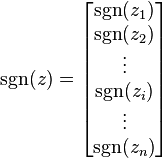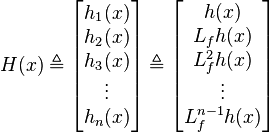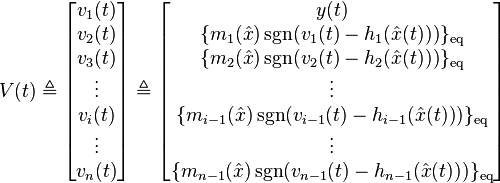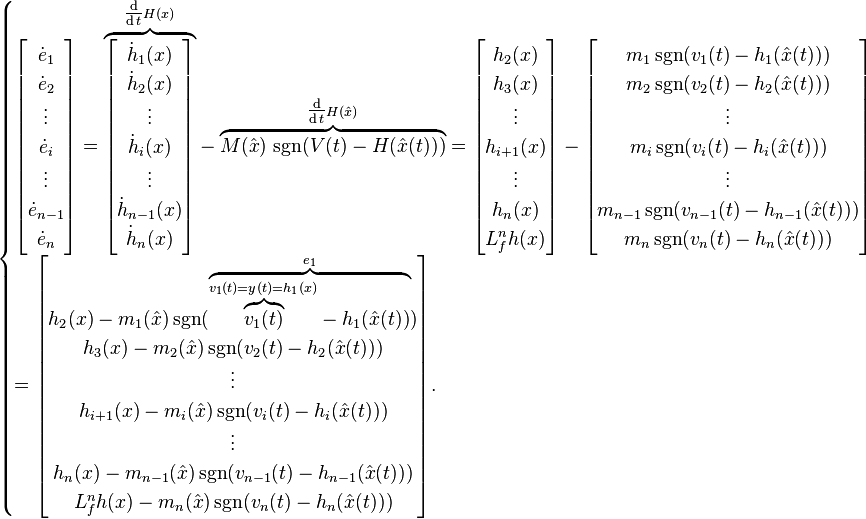State observer
In control theory, a state observer is a system that provides an estimate of the internal state of a given real system, from measurements of the input and output of the real system. It is typically computer-implemented, and provides the basis of many practical applications.
Knowing the system state is necessary to solve many control theory problems; for example, stabilizing a system using state feedback. In most practical cases, the physical state of the system cannot be determined by direct observation. Instead, indirect effects of the internal state are observed by way of the system outputs. A simple example is that of vehicles in a tunnel: the rates and velocities at which vehicles enter and leave the tunnel can be observed directly, but the exact state inside the tunnel can only be estimated. If a system is observable, it is possible to fully reconstruct the system state from its output measurements using the state observer.
Typical observer model
The state of a linear, time-invariant physical discrete-time system is assumed to satisfy
where, at time  ,
,  is the plant's state;
is the plant's state;  is its inputs; and
is its inputs; and  is its outputs. These equations simply say that the plant's current outputs and its future state are both determined solely by its current states and the current inputs. (Although these equations are expressed in terms of discrete time steps, very similar equations hold for continuous systems). If this system is observable then the output of the plant,
is its outputs. These equations simply say that the plant's current outputs and its future state are both determined solely by its current states and the current inputs. (Although these equations are expressed in terms of discrete time steps, very similar equations hold for continuous systems). If this system is observable then the output of the plant,  , can be used to steer the state of the state observer.
, can be used to steer the state of the state observer.
The observer model of the physical system is then typically derived from the above equations. Additional terms may be included in order to ensure that, on receiving successive measured values of the plant's inputs and outputs, the model's state converges to that of the plant. In particular, the output of the observer may be subtracted from the output of the plant and then multiplied by a matrix  ; this is then added to the equations for the state of the observer to produce a so-called Luenberger observer, defined by the equations below. Note that the variables of a state observer are commonly denoted by a "hat":
; this is then added to the equations for the state of the observer to produce a so-called Luenberger observer, defined by the equations below. Note that the variables of a state observer are commonly denoted by a "hat":  and
and  to distinguish them from the variables of the equations satisfied by the physical system.
to distinguish them from the variables of the equations satisfied by the physical system.
The observer is called asymptotically stable if the observer error  converges to zero when
converges to zero when  . For a Luenberger observer, the observer error satisfies
. For a Luenberger observer, the observer error satisfies  . The Luenberger observer for this discrete-time system is therefore asymptotically stable when the matrix
. The Luenberger observer for this discrete-time system is therefore asymptotically stable when the matrix  has all the eigenvalues inside the unit circle.
has all the eigenvalues inside the unit circle.
For control purposes the output of the observer system is fed back to the input of both the observer and the plant through the gains matrix  .
.
The observer equations then become:
or, more simply,
Due to the separation principle we know that we can choose  and
and  independently without harm to the overall stability of the systems. As a rule of thumb, the poles of the observer
independently without harm to the overall stability of the systems. As a rule of thumb, the poles of the observer  are usually chosen to converge 10 times faster than the poles of the system
are usually chosen to converge 10 times faster than the poles of the system  .
.
Continuous-time case
The previous example was for an observer implemented in a discrete-time LTI system. However, the process is similar for the continuous-time case; the observer gains  are chosen to make the continuous-time error dynamics converge to zero asymptotically (i.e., when
are chosen to make the continuous-time error dynamics converge to zero asymptotically (i.e., when  is a Hurwitz matrix).
is a Hurwitz matrix).
For a continuous-time linear system
where  , the observer looks similar to discrete-time case described above:
, the observer looks similar to discrete-time case described above:
-
 .
.
The observer error  satisfies the equation
satisfies the equation
-
 .
.
The eigenvalues of the matrix  can be made arbitrarily by appropriate choice of the observer gain
can be made arbitrarily by appropriate choice of the observer gain  when the pair
when the pair ![[A,C]](../I/m/076323ef7554f221c8070ad5de5c22b8.png) is observable, i.e. observability condition holds. In particular, it can be made Hurwitz, so the observer error
is observable, i.e. observability condition holds. In particular, it can be made Hurwitz, so the observer error  when
when  .
.
Peaking and other observer methods
When the observer gain  is high, the linear Luenberger observer converges to the system states very quickly. However, high observer gain leads to a peaking phenomenon in which initial estimator error can be prohibitively large (i.e., impractical or unsafe to use).[1] As a consequence, nonlinear high gain observer methods are available that converge quickly without the peaking phenomenon. For example, sliding mode control can be used to design an observer that brings one estimated state's error to zero in finite time even in the presence of measurement error; the other states have error that behaves similarly to the error in a Luenberger observer after peaking has subsided. Sliding mode observers also have attractive noise resilience properties that are similar to a Kalman filter.[2][3]
is high, the linear Luenberger observer converges to the system states very quickly. However, high observer gain leads to a peaking phenomenon in which initial estimator error can be prohibitively large (i.e., impractical or unsafe to use).[1] As a consequence, nonlinear high gain observer methods are available that converge quickly without the peaking phenomenon. For example, sliding mode control can be used to design an observer that brings one estimated state's error to zero in finite time even in the presence of measurement error; the other states have error that behaves similarly to the error in a Luenberger observer after peaking has subsided. Sliding mode observers also have attractive noise resilience properties that are similar to a Kalman filter.[2][3]
State observers for nonlinear systems
Sliding mode observers can be designed for the non-linear systems as well. For simplicity, first consider the no-input non-linear system:
where  . Also assume that there is a measurable output
. Also assume that there is a measurable output  given by
given by
There are several non-approximate approaches for designing an observer. The two observers given below also apply to the case when the system has an input. That is,
-

-
 .
.
Linearizable error dynamics
One suggestion by Krener and Isidori[4] and Krener and Respondek[5] can be applied in a situation when there exists a linearizing transformation (i.e., a diffeomorphism, like the one used in feedback linearization)  such that in new variables the system equations read
such that in new variables the system equations read
The Luenberger observer is then designed as
-
 .
.
The observer error for the transformed variable  satisfies the same equation as in classical linear case.
satisfies the same equation as in classical linear case.
-
 .
.
As shown by Gauthier, Hammouri, and Othman[6]
and Hammouri and Kinnaert,[7] if there exists transformation  such that the system can be transformed into the form
such that the system can be transformed into the form
then the observer is designed as
-
 ,
,
where  is a time-varying observer gain.
is a time-varying observer gain.
Ciccarella, Dalla Mora, and Germani [8] obtained more advanced and general results, removing the need for a nonlinear transform and proving global asymptotic convergence of the estimated state to the true state using only simple assumptions on regularity.
Sliding mode observer
As discussed for the linear case above, the peaking phenomenon present in Luenberger observers justifies the use of a sliding mode observer. The sliding mode observer uses non-linear high-gain feedback to drive estimated states to a hypersurface where there is no difference between the estimated output and the measured output. The non-linear gain used in the observer is typically implemented with a scaled switching function, like the signum (i.e., sgn) of the estimated – measured output error. Hence, due to this high-gain feedback, the vector field of the observer has a crease in it so that observer trajectories slide along a curve where the estimated output matches the measured output exactly. So, if the system is observable from its output, the observer states will all be driven to the actual system states. Additionally, by using the sign of the error to drive the sliding mode observer, the observer trajectories become insensitive to many forms of noise. Hence, some sliding mode observers have attractive properties similar to the Kalman filter but with simpler implementation.[2][3]
As suggested by Drakunov,[9] a sliding mode observer can also be designed for a class of non-linear systems. Such an observer can be written in terms of original variable estimate  and has the form
and has the form
where:
- The
 vector extends the scalar signum function to
vector extends the scalar signum function to  dimensions. That is,
dimensions. That is,
- for the vector
 .
.
- The vector
 has components that are the output function
has components that are the output function  and its repeated Lie derivatives. In particular,
and its repeated Lie derivatives. In particular,
- where
 is the ith Lie derivative of output function
is the ith Lie derivative of output function  along the vector field
along the vector field  (i.e., along
(i.e., along  trajectories of the non-linear system). In the special case where the system has no input or has a relative degree of n,
trajectories of the non-linear system). In the special case where the system has no input or has a relative degree of n,  is a collection of the output
is a collection of the output  and its
and its  derivatives. Because the inverse of the Jacobian linearization of
derivatives. Because the inverse of the Jacobian linearization of  must exist for this observer to be well defined, the transformation
must exist for this observer to be well defined, the transformation  is guaranteed to be a local diffeomorphism.
is guaranteed to be a local diffeomorphism.
- The diagonal matrix
 of gains is such that
of gains is such that
- where, for each
 , element
, element  and suitably large to ensure reachability of the sliding mode.
and suitably large to ensure reachability of the sliding mode.
- The observer vector
 is such that
is such that
- where
 here is the normal signum function defined for scalars, and
here is the normal signum function defined for scalars, and  denotes an "equivalent value operator" of a discontinuous function in sliding mode.
denotes an "equivalent value operator" of a discontinuous function in sliding mode.
The idea can be briefly explained as follows. According to the theory of sliding modes, in order to describe the system behavior, once sliding mode starts, the function  should be replaced by equivalent values (see equivalent control in the theory of sliding modes). In practice, it switches (chatters) with high frequency with slow component being equal to the equivalent value. Applying appropriate lowpass filter to get rid of the high frequency component on can obtain the value of the equivalent control, which contains more information about the state of the estimated system. The observer described above uses this method several times to obtain the state of the nonlinear system ideally in finite time.
should be replaced by equivalent values (see equivalent control in the theory of sliding modes). In practice, it switches (chatters) with high frequency with slow component being equal to the equivalent value. Applying appropriate lowpass filter to get rid of the high frequency component on can obtain the value of the equivalent control, which contains more information about the state of the estimated system. The observer described above uses this method several times to obtain the state of the nonlinear system ideally in finite time.
The modified observation error can be written in the transformed states  . In particular,
. In particular,
and so
So:
- As long as
 , the first row of the error dynamics,
, the first row of the error dynamics,  , will meet sufficient conditions to enter the
, will meet sufficient conditions to enter the  sliding mode in finite time.
sliding mode in finite time. - Along the
 surface, the corresponding
surface, the corresponding  equivalent control will be equal to
equivalent control will be equal to  , and so
, and so  . Hence, so long as
. Hence, so long as  , the second row of the error dynamics,
, the second row of the error dynamics,  , will enter the
, will enter the  sliding mode in finite time.
sliding mode in finite time. - Along the
 surface, the corresponding
surface, the corresponding  equivalent control will be equal to
equivalent control will be equal to  . Hence, so long as
. Hence, so long as  , the
, the  th row of the error dynamics,
th row of the error dynamics,  , will enter the
, will enter the  sliding mode in finite time.
sliding mode in finite time.
So, for sufficiently large  gains, all observer estimated states reach the actual states in finite time. In fact, increasing
gains, all observer estimated states reach the actual states in finite time. In fact, increasing  allows for convergence in any desired finite time so long as each
allows for convergence in any desired finite time so long as each  function can be bounded with certainty. Hence, the requirement that the map
function can be bounded with certainty. Hence, the requirement that the map  is a diffeomorphism (i.e., that its Jacobian linearization is invertible) asserts that convergence of the estimated output implies convergence of the estimated state. That is, the requirement is an observability condition.
is a diffeomorphism (i.e., that its Jacobian linearization is invertible) asserts that convergence of the estimated output implies convergence of the estimated state. That is, the requirement is an observability condition.
In the case of the sliding mode observer for the system with the input, additional conditions are needed for the observation error to be independent of the input. For example, that
does not depend on time. The observer is then
Bounding observers
The Bounding [10] or Interval observers [11] constitute a class of observers that provide two estimations of the state simultaneously: one of the estimation provides an upper bound on the real value of the state, whereas the second one provides a lower bound. The real value of the state is then known to be always within these two estimations.
These bounds are very important in practical applications,[12][13] as they make possible to know at each time the precision of the estimation.
Mathematically, two Luenberger observers can be used, if  is properly selected, using, for example, positive systems properties:[14] one for the upper bound
is properly selected, using, for example, positive systems properties:[14] one for the upper bound  (that ensures that
(that ensures that  converges to zero from above when
converges to zero from above when  , in the absence of noise and uncertainty), and a lower bound
, in the absence of noise and uncertainty), and a lower bound  (that ensures that
(that ensures that  converges to zero from below). That is, always
converges to zero from below). That is, always 
See also
References
- In-line references
- ↑ Khalil, H.K. (2002), Nonlinear Systems (3rd ed.), Upper Saddle River, NJ: Prentice Hall, ISBN 0-13-067389-7
- 1 2 Utkin, Vadim; Guldner, Jürgen; Shi, Jingxin (1999), Sliding Mode Control in Electromechanical Systems, Philadelphia, PA: Taylor & Francis, Inc., ISBN 0-7484-0116-4
- 1 2 Drakunov, S.V. (1983), "An adaptive quasioptimal filter with discontinuous parameters", Automation and Remote Control 44 (9): 1167–1175
- ↑ Krener, A.J.; Isidori, Alberto (1983), "Linearization by output injection and nonlinear observers", System and Control Letters 3: 47–52, doi:10.1016/0167-6911(83)90037-3
- ↑ Krener, A.J.; Respondek, W. (1985), "Nonlinear observers with linearizable error dynamics", SIAM Journal on Control and Optimization 23 (2): 197–216, doi:10.1137/0323016
- ↑ Gauthier, J.P.; Hammouri, H.; Othman, S. (1992), "A simple observer for nonlinear systems applications to bioreactors", IEEE Transactions on AC 37 (6): 875–880, doi:10.1109/9.256352
- ↑ Hammouri, H.; Kinnaert, M. (1996), "A New Procedure for Time-Varying Linearization up to Output Injection", System and Control Letters 28 (3): 151–157, doi:10.1016/0167-6911(96)00022-9
- ↑ Ciccarella, G.; Dalla Mora, M.; Germani, A. (1993), "A Luenberger-like observer for nonlinear systems", International Journal of Control 57 (3): 537–556, doi:10.1080/00207179308934406
- ↑ Drakunov, S.V. (1992), "Sliding-Mode Observers Based on Equivalent Control Method", Proceedings of the 31st IEEE Conference on Decision and Control (CDC) (Tucson, Arizona, December 16–18): 2368–2370, doi:10.1109/CDC.1992.371368, ISBN 0-7803-0872-7
- ↑ http://www.nt.ntnu.no/users/skoge/prost/proceedings/ecc03/pdfs/437.pdf
- ↑ http://www.nt.ntnu.no/users/skoge/prost/proceedings/cdc-2008/data/papers/1446.pdf
- ↑ http://www.iaeng.org/publication/WCE2010/WCE2010_pp656-661.pdf
- ↑ "Estimation of uncertain models of activated sludge processes with interval observers". Journal of Process Control 11: 299–310. doi:10.1016/S0959-1524(99)00074-8.
- ↑ Ait Rami, M., Tadeo, F., Helmke, U. (2011), "Positive observers for linear positive systems, and their implications", International Journal of Control 84
- General references
- Sontag, Eduardo (1998), Mathematical Control Theory: Deterministic Finite Dimensional Systems. Second Edition, Springer, ISBN 0-387-98489-5


![\hat{x}(k+1) = A \hat{x}(k) + L \left[y(k) - \hat{y}(k)\right] + B u(k)](../I/m/74168b80059bd361b3e0c5785e8ce0cd.png)















![\dot{\hat{x}} = \left [ \frac{\partial H(\hat{x})}{\partial x}
\right]^{-1} M(\hat{x}) \, \operatorname{sgn}( V(t) - H(\hat{x}) )](../I/m/2e3db29fd657f839e296626263067db7.png)







![\dot{\hat{x}} = \left[ \frac{\partial H(\hat{x})}{\partial x}
\right]^{-1} M(\hat{x}) \operatorname{sgn}(V(t) - H(\hat{x}))+B(\hat{x})u.](../I/m/bb81e9410497397bc1f4e06a459db549.png)